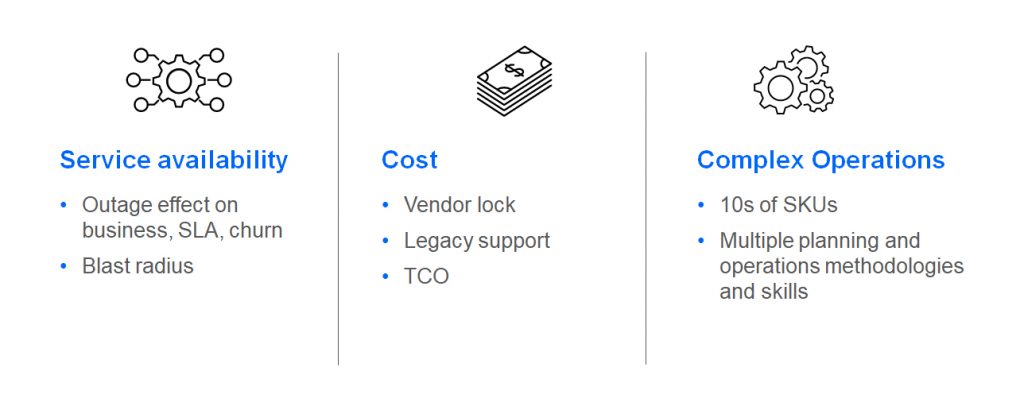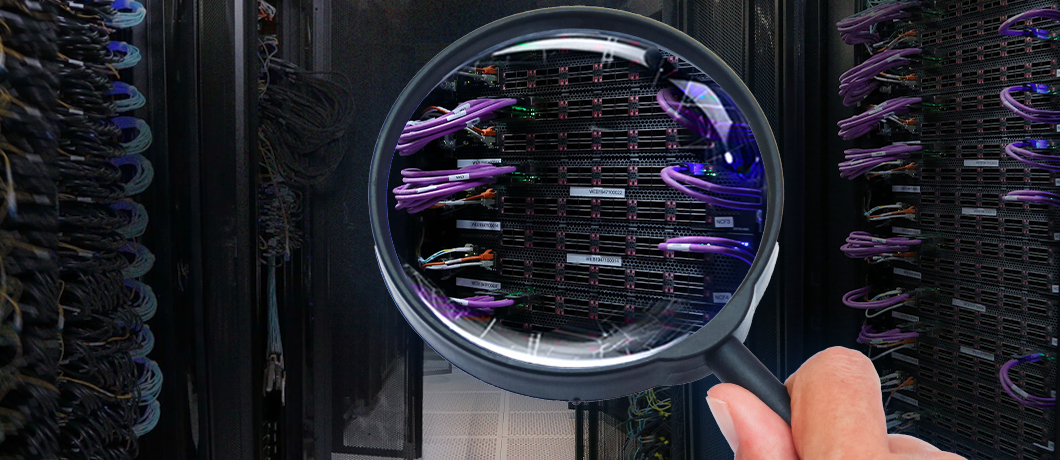|
Getting your Trinity Audio player ready...
|
This has led to a pivotal moment where innovation is not merely an option – it’s a necessity for survival and growth. In this blog post, we will explore the emerging trends and challenges that are reshaping network infrastructure. We also will discuss how SPs are adopting a new strategy to build networks that are not only robust and scalable, but also flexible and cost-effective for managing today’s unprecedented digital demands.
Top network operator challenges
Telecom service providers are facing significant challenges that are reshaping the way they conduct business and maintain networks. These challenges require innovative solutions and a rethinking of traditional operations.

Firstly, service availability has emerged as a nonnegotiable aspect of telecom operations. In the digital age, an outage is more than a technical glitch; it’s a direct hit to the business’s heart, affecting customer satisfaction/churn, breaching service level agreements (SLAs), and, in turn, impacting the business’s bottom line. Furthermore, the “blast radius” of outages, a term that refers to an outage’s extent of impact, has grown significantly; in a hyper-connected world, a single point of failure can trigger a domino effect that extends far beyond the initial problem.
Secondly, costs are multifaceted. The traditional vendor lock-in scenario, where operators are dependent on a single supplier for equipment and services, is proving to be a costly affair in terms of both capital expenditure and operational flexibility. Legacy systems compound this issue, as they are often expensive to maintain and challenging to integrate with newer technologies. Overall, total cost of ownership (TCO) is a major concern for operators looking to streamline their expenses while upgrading their capabilities.
Lastly, operational complexity poses a significant hurdle. With the presence of tens of different stock keeping units (SKUs), the complexity of managing inventory and operations increases manifold. This complexity is further amplified by the multitude of planning and operational methodologies, each requiring a unique skill set, which can lead to inefficiencies and errors.
To address these challenges, operators are reevaluating their network architectures with a focus on flexibility, cost efficiency, and robustness. The path forward involves a strategic blend of innovation and a willingness to break away from the confines of traditional network architecture practices.
Required paradigm shift for high-scale network architectures
As service providers grapple with the challenges outlined above, a revolutionary network architecture is gaining momentum – building networks like cloud. Representing a shift towards a more streamlined and unified network architecture, this evolution is centered around three core concepts.
The first concept, unified network hardware, is a game-changer. It involves the standardization of network hardware across all sites and functions, regardless of scale. By using simple, modular and standard white boxes as building blocks, operators can deploy a uniform set of hardware that supports a wide range of network use cases —from the edge to the core. Moreover, such white boxes can be deployed from a stand-alone white box to large-scale clusters. This uniformity allows for easier maintenance, quicker upgrades, and a significant reduction in the complexity associated with managing a diverse set of hardware platforms.
The second pivotal concept is collapsed network layers. Traditional network architecture is composed of multiple layers, such as optics, IP/MPLS, and applications, each typically functioning on separate hardware. The new approach collapses these layers into a single cohesive layer, which can significantly streamline network operations and potentially reduce latency.
Leaner infrastructure – collapsing network layers
The vision extends even further with the anticipation of collapsing all layers (from layer 1 to layer 7) in the future. This would result in unprecedented efficiency and simplicity in network design and operations.
Lastly, network-wide orchestration represents the peak of this architectural revolution. Zero-touch provisioning (ZTP) eliminates the need for manual intervention in the setup of new network elements, while AI operations (AIOps) harnesses the power of artificial intelligence to manage the network more efficiently and predictively. The goal is to move away from the traditional command-line interface (CLI) that has been the staple of network management, towards a more automated and intelligent system that can orchestrate the entire network’s operations.
Redefining network paradigms
This strategic shift towards a new network architecture is more than just an upgrade – it’s a redefinition of network paradigms that aligns with the future of digital connectivity. By embracing these concepts, SPs applying disaggregation are paving the way not only for more resilient and agile network operations, but also for the next generation of networking – one that is smarter, more seamless, and inherently more responsive to the needs of the digital world.
Build networks like cloud
To solve the scaling and complexity challenges of service providers network, DriveNets has adapted the hyperscalers’ model to the service provider networks and applied disaggregation. DriveNets’ distributed cloud-native software uses containers and microservices over a virtualization layer to better utilize the shared white box hardware. Routing protocols have been redesigned to meet the large scale demands of the disaggregated router. The multiple disaggregated hardware and software components are managed centrally as a single routing entity to provide service providers with the operational simplicity they crave.
Download
Introducing DriveNets Network Cloud




